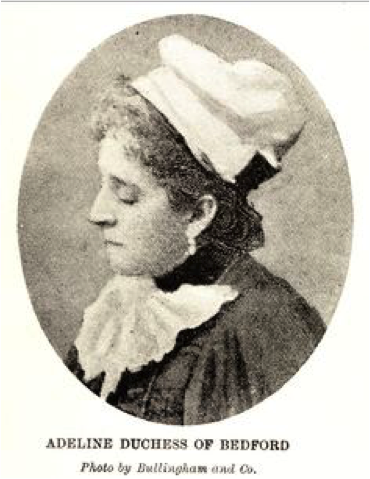Dr Rachel Bennett (University of Warwick)
Identifying and Advocating for Women’s Health: The Duchess of Bedford’s 1919 Committee of Enquiry into Medical Care in Holloway Prison
Opened in 1852, Holloway Prison was the City of London House of Correction and it accommodated both male and female prisoners. The prison’s turreted gateway and imposing structure earned it the moniker of ‘The Castle’. Newgate Prison was closed in 1902 and the increasing pressure for prison space prompted the decision to make Holloway a female-only prison in 1903. It was reported that, in addition to addressing the issue of prison space, this decision also met a broader aim of facilitating the ‘absolute separation of the sexes’.[1] Holloway became the largest female prison in England but was quickly faced with overcrowding and a new wing had to be added in 1906. During the First World War, the prison witnessed shortages of provisions and medical staff, which resulted in it becoming a site for enquiry and a subject of debate over healthcare in prisons.
Duchess of Bedford

Adeline Mary Russell (1852-1920), the Duchess of Bedford, was a philanthropist and penal reformer. Between the late nineteenth and early twentieth century she was involved in several campaigns aimed at the moral and occupational improvement of women’s lives. These included a movement to rescue women working in prostitution around Victoria Station in London and working with the Associated Workers’ League to address the conditions facing women at work.[2] In addition, she regularly consulted with Sir Evelyn Ruggles-Brise, the chairman of the Prison Commission who governed all English and Welsh prisons, about women in prison. In the late 1890s, she regularly visited Aylesbury, which had become a female-only prison in 1890, and worked to place women into ‘homes’ upon their release to help them gain employment. In 1900, she became the first president of the National Lady Visitors’ Association. The Lady Visitors visited women in prisons, including Holloway and Aylesbury, and sought to educate them and to help them prepare for life after their imprisonment.
Enquiry into Conditions at Holloway
In 1919, the Duchess of Bedford was asked by Ruggles-Brise to chair a committee of enquiry into conditions in Holloway prison. The enquiry was, in part, born out of concerns that were being raised over the conditions of women received into the release ‘homes’ from Holloway. However, it also occurred at a time when cases of poor medical treatment, several of which had resulted in the death of prisoners, increased public anxiety over conditions within Holloway. Therefore, in conducting the enquiry, the committee took the opportunity to examine several aspects of medical care in the prison including sanitary conditions, provisions for childbirth and maternity care and the treatment of venereal disease in remand and convicted prisoners. A reading of the committee’s findings, their recommendations and the responses to these issues by the Prison Commission offers a valuable insight into conditions in the prison, including the organisation of the hospital, the availability of specially trained staff and the physical spaces in which prisoners received medical treatment. For example, in 1883-84 a hospital wing had been added to Holloway. However, the enquiry identified a lack of designated wards to treat specific medical needs as they found that pregnant prisoners were accommodated in prison cells on the same landing as those being treated for epilepsy, tuberculosis and mental illness. The enquiry also highlighted how punitive considerations about security and the mixing of remand prisoners with convicted prisoners impacted upon medical care.[3]
Advocating for Female Prisoner Health
In addition to the valuable information we can glean from this enquiry about medical care in Holloway, it also offers an important example of how individual reformers and reform groups identified and advocated specifically for female prisoner health. The committee was comprised entirely of women and its members included the Duchess of Bedford as the chair, Miss Burrell and Miss Blunt, both Lady Visitors at Holloway, Mrs Gilbert Samuel, Chairman of the Prison Reform Committee in connection with the Joint Parliamentary Advisory Council, and a female medical practitioner, Dr Ada Whitlock, a Lady Inspector of the Reformatory and Industrial School Department.
Women’s Freedom League
In the nineteenth century penal reformers, perhaps the most famous being the Quaker and philanthropist Elizabeth Fry, had advocated specifically for the needs of women in prison. Fry had strongly advocated for the separation of male and female prisoners and had also argued that women in prison should be offered moral and religious guidance, and be supervised, by other women. By the mid-nineteenth century, several women’s prisons had female superintendents who oversaw the daily governance of the institutions. However, by the early twentieth century there were increasing arguments, made by several women’s reform groups, that women should be given greater power and responsibility to make administrative decisions in the management of women’s prisons, including those over the provisions for medical care. Several suffragettes had highlighted the poor conditions in Holloway and in other prisons following their own incarceration in the early twentieth century. The issue was also taken up by groups including the Women’ Freedom League, which continued to petition the Home Office for much of the first half of the twentieth century over the appointment of female governors and medical officers in women’s prisons. Therefore, the enquiry of 1919 can be situated within a broader and longer term history of discussions and debates identifying and advocating for women’s health in prison.
Return to Background Reading
Notes
Image Credit: Holloway Prison. Victorian London. A Pictorial and Descriptive Record of the Streets, Buildings, Parks and Scenery of the Great Metropolis, 1896. Public Domain.
[1] Report of the Commissioners of Prisons and the Directors of Convict Prisons (1902), p. 7.
[2] B. Forsythe, ‘Russell, Adeline Mary, duchess of Bedford (1852-1920)’ in The Oxford Dictionary of National Biography (Oxford, 2004).
[3] Holloway Prison: Duchess of Bedford’s Committee of Enquiry into Various Matters (1919) (The National Archives).